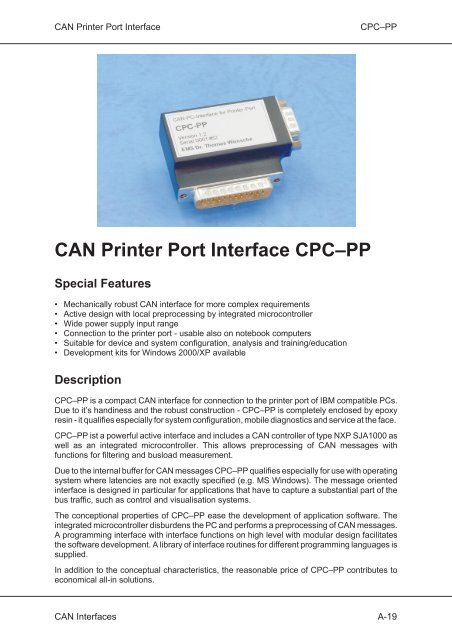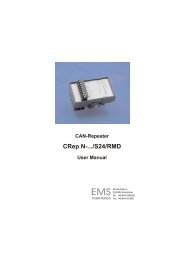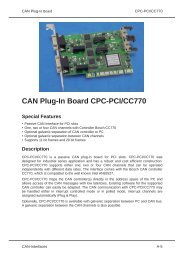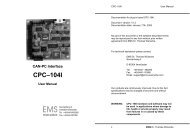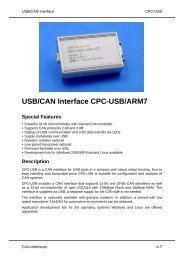CAN Printer Port Interface CPCâPP - Ems-wuensche.com
CAN Printer Port Interface CPCâPP - Ems-wuensche.com
CAN Printer Port Interface CPCâPP - Ems-wuensche.com
You also want an ePaper? Increase the reach of your titles
YUMPU automatically turns print PDFs into web optimized ePapers that Google loves.
<strong>CAN</strong> <strong>Printer</strong> <strong>Port</strong> <strong>Interface</strong><br />
CPC–PP<br />
<strong>CAN</strong> <strong>Printer</strong> <strong>Port</strong> <strong>Interface</strong> CPC–PP<br />
Special Features<br />
• Mechanically robust <strong>CAN</strong> interface for more <strong>com</strong>plex requirements<br />
• Active design with local preprocessing by integrated microcontroller<br />
• Wide power supply input range<br />
• Connection to the printer port - usable also on notebook <strong>com</strong>puters<br />
• Suitable for device and system configuration, analysis and training/education<br />
• Development kits for Windows 2000/XP available<br />
Description<br />
CPC–PP is a <strong>com</strong>pact <strong>CAN</strong> interface for connection to the printer port of IBM <strong>com</strong>patible PCs.<br />
Due to it’s handiness and the robust construction - CPC–PP is <strong>com</strong>pletely enclosed by epoxy<br />
resin - it qualifies especially for system configuration, mobile diagnostics and service at the face.<br />
CPC–PP ist a powerful active interface and includes a <strong>CAN</strong> controller of type NXP SJA1000 as<br />
well as an integrated microcontroller. This allows preprocessing of <strong>CAN</strong> messages with<br />
functions for filtering and busload measurement.<br />
Due to the internal buffer for <strong>CAN</strong> messages CPC–PP qualifies especially for use with operating<br />
system where latencies are not exactly specified (e.g. MS Windows). The message oriented<br />
interface is designed in particular for applications that have to capture a substantial part of the<br />
bus traffic, such as control and visualisation systems.<br />
The conceptional properties of CPC–PP ease the development of application software. The<br />
integrated microcontroller disburdens the PC and performs a preprocessing of <strong>CAN</strong> messages.<br />
A programming interface with interface functions on high level with modular design facilitates<br />
the software development. A library of interface routines for different programming languages is<br />
supplied.<br />
In addition to the conceptual characteristics, the reasonable price of CPC–PP contributes to<br />
economical all-in solutions.<br />
<strong>CAN</strong> <strong>Interface</strong>s A-19
CPC–PP<br />
<strong>CAN</strong> <strong>Printer</strong> <strong>Port</strong> <strong>Interface</strong><br />
Technical Data<br />
Bus <strong>Interface</strong><br />
Type of the physical connection<br />
ISO 11898 with transceiver PCA82C251<br />
Maximum voltage on bus connections<br />
± 30V referring to bus ground<br />
Supply voltage CPC-PP 7 – 14V<br />
CPC-PP/EX 12 – 30V<br />
Configuration<br />
Base address in PC memory<br />
PC Interrupt (optional)<br />
I/0 range of the corresponding printer port<br />
IRQ of the corresponding interrupt<br />
Scope of Delivery<br />
• <strong>CAN</strong> printer port interface CPC–PP<br />
• User Manual<br />
• pro<strong>CAN</strong>tool <strong>CAN</strong>-Monitor for operating systems Windows 2000/XP<br />
A-20 <strong>CAN</strong> <strong>Interface</strong>s


